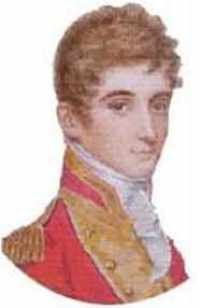José Miguel de la Cueva, 14th Duke of Alburquerque facts for kids
Quick facts for kids
José Miguel de la Cueva y de la Cerda
|
|
|---|---|
| 14th Duke of Alburquerque | |
 |
|
| Born | 26 December 1775 Madrid |
| Died | 18 February 1811 (aged 35) London |
| Occupation | General |
José Miguel de la Cueva y de la Cerda (1775–1811) was a Spanish general, diplomat, and a nobleman. He held the title of the 14th Duke of Alburquerque. He played an important role as a senior officer for Spain during the Peninsular War.
Contents
Life as a General
Early Military Career
José Miguel started his military journey as a cadet. He joined the Queen's Dragoons Regiment. In 1792, he became a captain.
He quickly moved up the ranks. This was partly thanks to his family's influence. By 1793, he was a lieutenant colonel. The next year, he became a colonel. In 1795, at just 19 years old, he was promoted to Cavalry brigadier. He was then given command of the Lusitania Dragoons Regiment.
In 1803, he inherited his father's noble titles. After this, he decided to leave his regiment.
Serving in the Peninsular War
The Peninsular War was a big conflict in Spain. It happened between 1807 and 1814. Spain, Portugal, and the United Kingdom fought against Napoleon's French Empire.
1808: First Commands
When the war began, Alburquerque was put in charge. He commanded the Army of Castille. He served under General Pignatelli. Later, his army was dissolved. He then moved to General Castaños's group of soldiers.
1809: Rising Through the Ranks
In November, Alburquerque was promoted to field marshal. In January 1809, the Duke del Infantado gave him a new command. He led the front part of the Army of the Centre. This happened after the Spanish lost the Battle of Uclés.
In February, General Cartaojal took command of the Army of the Centre. Alburquerque still led the front division. This group had 2,000 horsemen and 9,000 foot soldiers. He tried to surprise a French cavalry group. Soon after, his division had to retreat. This happened when French forces arrived.
Alburquerque and Cartaojal disagreed on what to do next. Alburquerque wanted to advance on Toledo. Cartaojal wanted him to go alone with a smaller group. Orders then came from the Supreme Junta. They needed to send troops to strengthen another army. Cartaojal used this chance to send Alburquerque away. He went with seven infantry battalions and a cavalry regiment. They arrived just in time for the Battle of Medellín. In April, Alburquerque was promoted to lieutenant general.
In July, Alburquerque commanded six cavalry regiments. They were part of the Army of the Centre. This was during the Battle of Talavera.
The next month, he suffered a defeat. This was at the Battle of Arzobispo on August 8. He showed personal bravery, but his army lost many soldiers. They lost over 800 men killed or wounded. About 600 men and 400 horses were captured. They also lost 16 cannons.
1810: Defending Cadiz and Diplomacy
In 1810, Alburquerque commanded the Army of Estremadura. On February 4, he entered Cadiz with 11,000 men. This secured Cadiz as an important Spanish base. He was made governor of the city. However, he had disagreements with General Gregorio García de la Cuesta. Because of this, he resigned from his post.
On March 2, he became the captain general of Andalusia. He was also made president of the Junta of Cádiz. But he had more disagreements, this time with the Regency. He was removed from his position. At the end of March, he was appointed Spanish ambassador. He became the ambassador to the British royal court in London. He died the following February in London. His funeral was held at Westminster Abbey.
See also
 In Spanish: José María de la Cueva y de la Cerda para niños
In Spanish: José María de la Cueva y de la Cerda para niños
- Duke of Alburquerque

